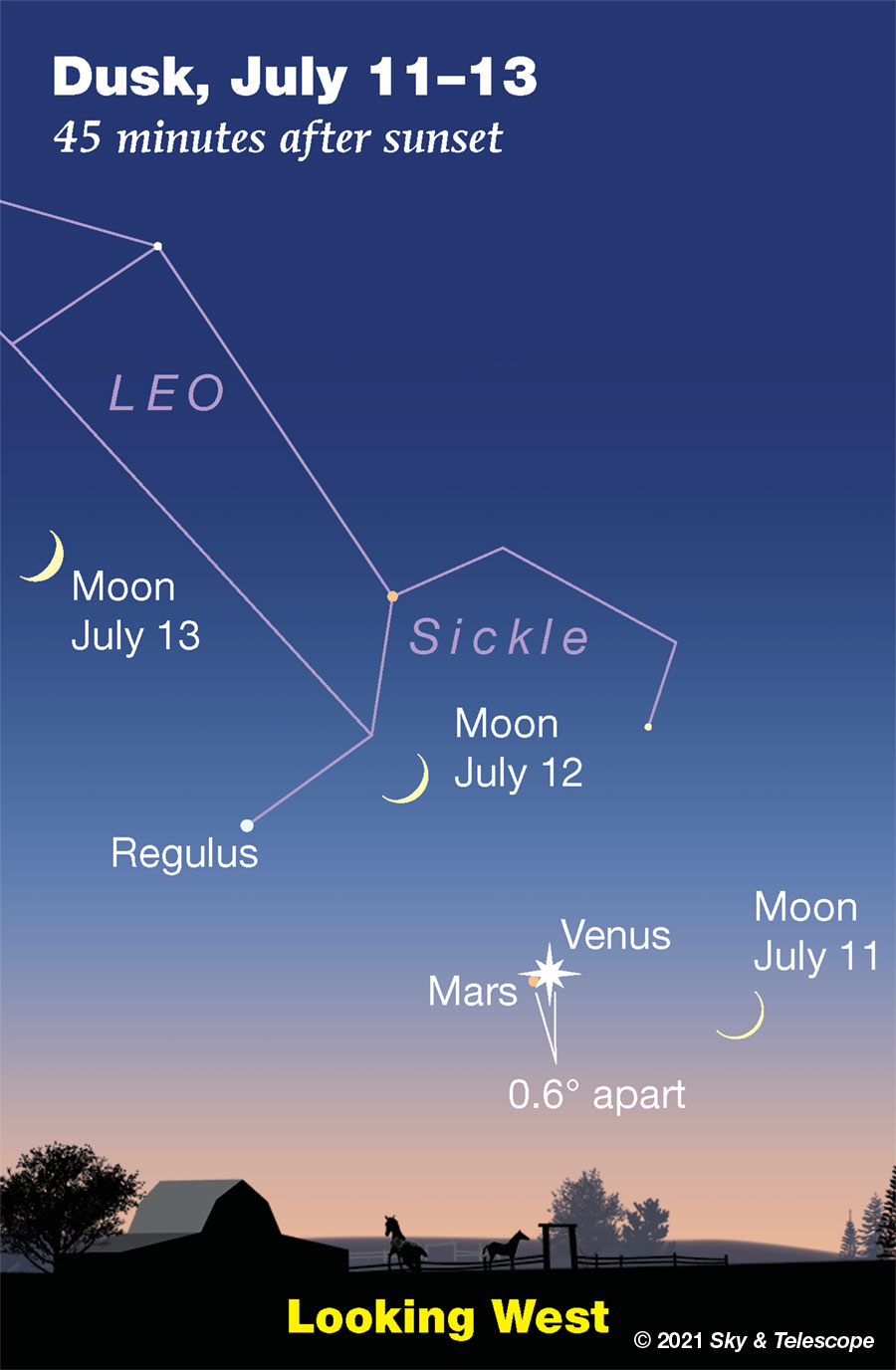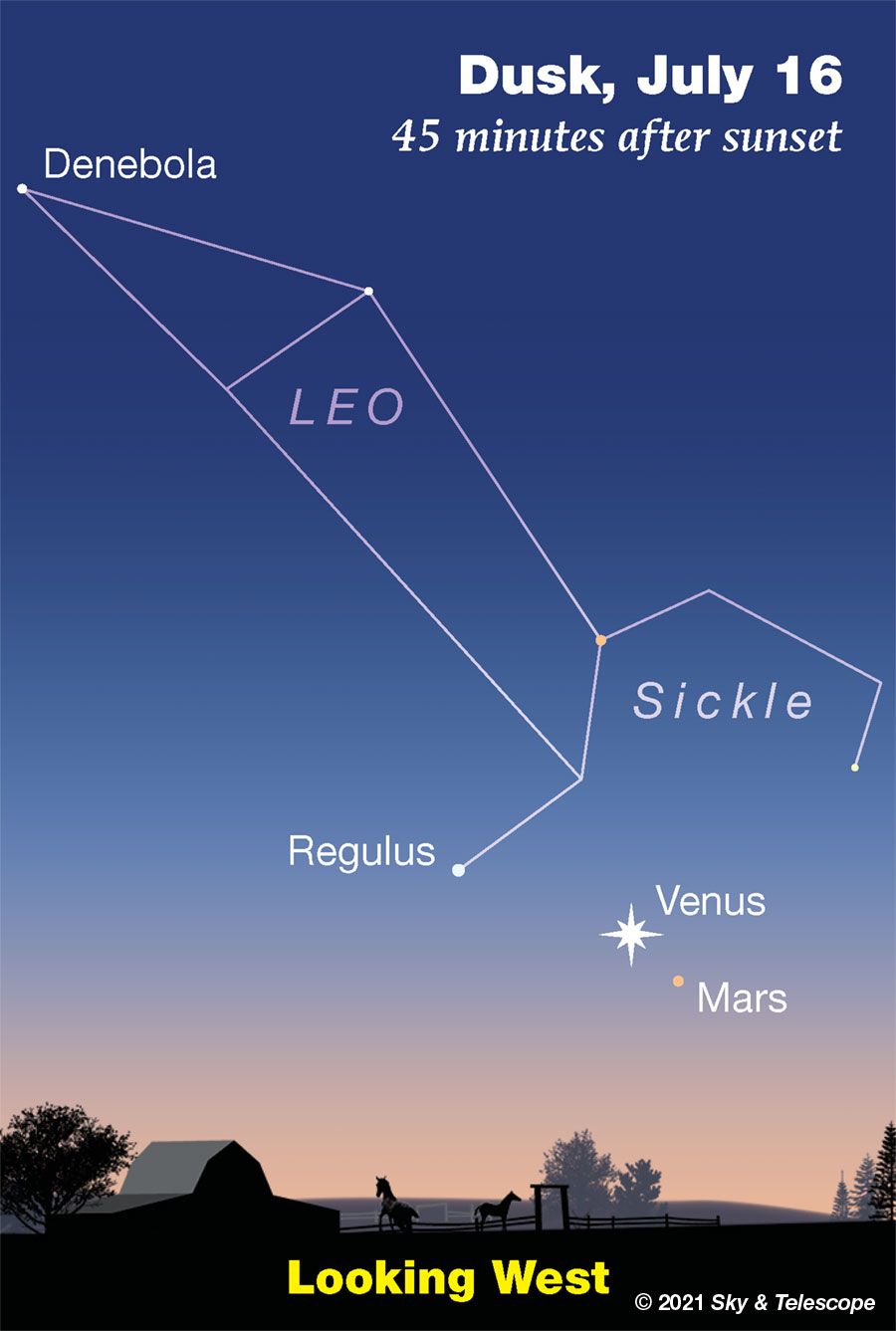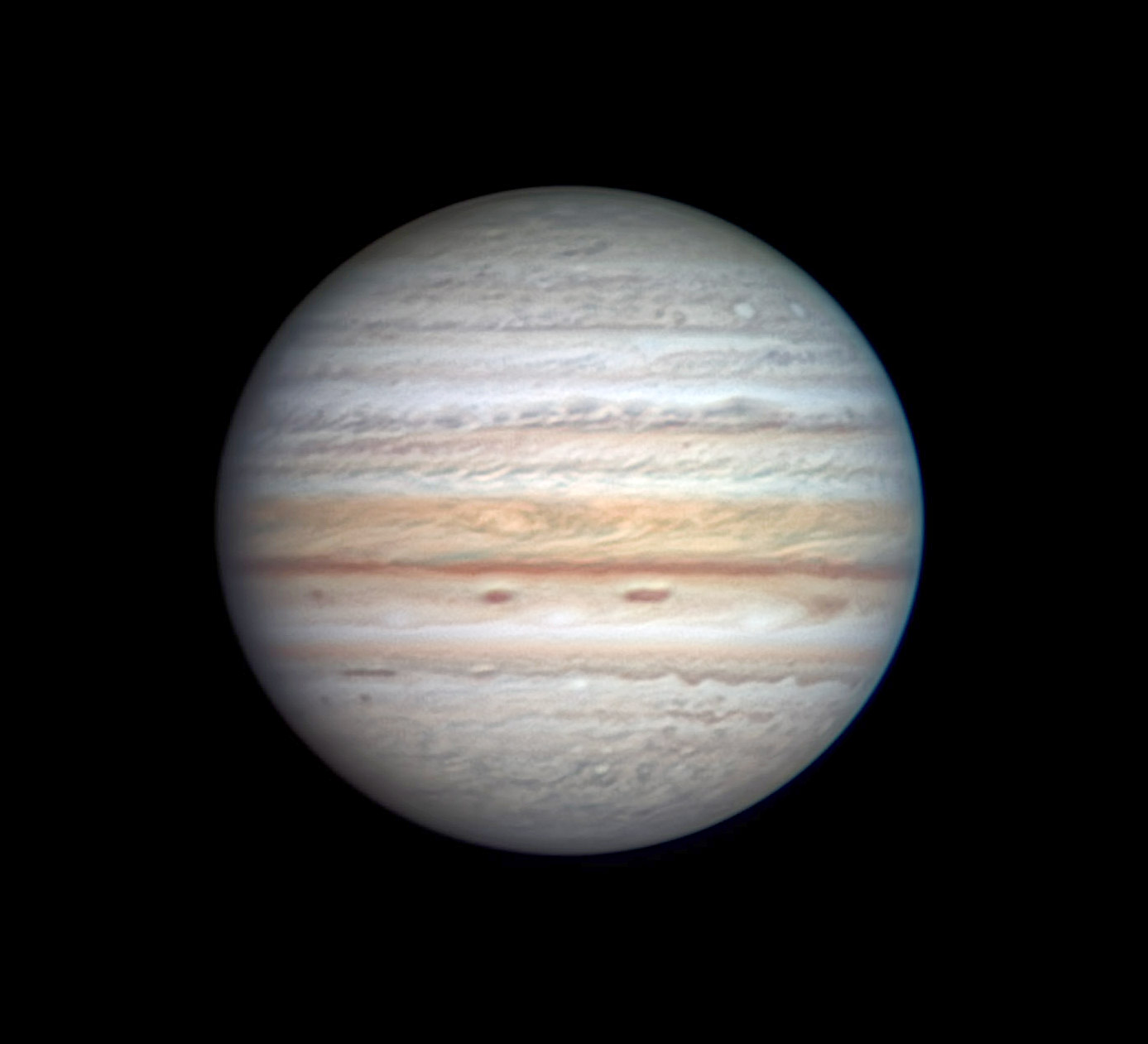Nova Cas continues wobbly. It's been nearly 4 months since Nova Cassiopeiae 2021 erupted to magnitude 7.7. It has stayed roughly that bright ever since, making it officially a "slow nova," except for swelling to 5.3 for a week in May. Recently it's been wavering. As of July 10th it was about 7.8, having dropped suddenly from a mini-peak of 6.6 the week before.
The nova is fairly well up in the north-northeast after dark, depending on your latitude. It climbs high later in the night. See Bob King's update: Noctilucent Cloud Show, a Mercurial Nova, and More, with charts and comparison stars.
FRIDAY, JULY 9
■ Venus continues to shine low in the west-northwest during twilight. Mars, only 1/200 as bright, is 2° to its upper left this evening; binoculars help. They set before twilight's end.
Watch the two planets close in and reach their conjunction about ½° apart on July 12th and 13th.
■ When twilight ends, you'll find the two brightest stars of summer, Vega and Arcturus, about equally near the zenith: Vega toward the east, Arcturus toward the southwest (depending on your location).
About a third of the way from Arcturus to Vega is the faint semicircle of Corona Borealis, the Northern Crown, with its modestly bright crown jewel, Alphecca or Gemma, on its front.
Nearly two thirds of the way from Arcturus to Vega is the Keystone of Hercules.
For more see Fred Schaaf's "The Path from Arcturus to Vega" in the July Sky & Telescope, page 45.
■ New Moon (exact at 9:17 p.m. EDT).
SATURDAY, JULY 10
■ If you have a dark enough sky on these last few nights before moonlight comes back, look for the Milky Way forming a magnificent arch high across the whole eastern sky. It runs all the way from below Cassiopeia in the north-northeast, up and across Cygnus and the bottom of the Summer Triangle in the east, and down past the spout of the Sagittarius Teapot in the south.
SUNDAY, JULY 11
■ The thin, two-day old crescent Moon hangs eerily a few degrees to the right of Venus (and faint little Mars) low in the west during twilight, as shown below.
If you can see Mars (bring binoculars), you can definitely see brighter Regulus twinkling 12° to Venus's upper left.

MONDAY, JULY 12
■ Big, macho Venus, Goddess of Love, and wimpy little Mars, God of War, are at their closest together now, about ½° apart, low in the west-northwest in twilight. This evening the crescent Moon shines upper left of them, as shown above.
Look for Regulus a little less far to the Moon's left or lower left.
TUESDAY, JULY 13
■ Mars is now ½° under Venus. The Moon has thickened and moved farther to their upper left. Regulus is about midway between the Moon and Venus, as shown above.
WEDNESDAY, JULY 14
■ The ever-waxing Moon is now lower left of Denebola, Leo's 2nd-magnitude tail tip. They're less than a fist at arm's length apart.
The brighter star way off three fists left of the Moon is 1st-magnitude Spica.
THURSDAY, JULY 15
■ With the advance of summer, the Sagittarius Teapot, in the south-southeast lower left of Scorpius after dark, is starting to tilt and pour from its spout to the right. The Teapot will tilt farther and farther for the rest of the summer — or for much of the night if you stay out late.
FRIDAY, JULY 16
■ In late twilight, Spica shines three or four finger-widths lower left of the first-quarter Moon (it's exactly first-quarter at 6:11 a.m. EDT Saturday the 17th). High above them is brighter Arcturus, tinted with a lower color temperature: yellow-orange.

■ The tail of Scorpius is low due south right after dark, to the lower right of the Sagittarius Teapot. How low depends on how far north or south you live: the farther south, the higher.
Look for the two stars especially close together in the tail. These are Lambda and fainter Upsilon Scorpii, known as the Cat's Eyes. They're canted at an angle; the cat is tilting his head a little to the right and winking (Upsilon is fainter than Lambda; they're magnitudes 1.6 and 2.6). Both are blue-white supergiants, 700 and 500 light years away, respectively. Yes, the nearer of the two is the fainter one.
Between the Cat's Eyes and the Teapot's spout are the open star clusters M6 and especially M7, showy in binoculars.
A line through the Cat's Eyes points west (right) by nearly a fist-width toward Mu Scorpii, a much tighter pair known as the Little Cat's Eyes. They're oriented almost exactly the same way as Lambda and Upsilon, and like those, they're not a true binary: they're 500 and 800 light-years from us. Can you resolve the Mu pair without binoculars?
SATURDAY, JULY 17
■ The Moon is still essentially first-quarter this evening (at the evening times for the Americas). Spot Spica a fist to the Moon's lower right, and Arcturus three times as far to the Moon's upper right.
■ Cassiopeia is now well past its bottoming-out for the year even as seen soon after dark. Look for its tilted W pattern lowish in the north-northeast. The farther north you live, the higher it will be.
This Week's Planet Roundup
Mercury glimmers very low in the east-northeast as dawn grows bright. It sinks a little lower this week but doubles in brightness, from magnitude 0.0 to –0.7. Binoculars help.
Don't confuse Mercury with Aldebaran increasingly far to its upper right, or Capella even farther upper left.
Venus (magnitude –3.9) continues to shine low in the west during twilight. Right near it is tiny Mars, 200 times fainter at magnitude +1.8. They appear closest, about ½° apart, at conjunction on July 12th and 13th. By the 16th Mars is 2° to Venus's lower right. Both planets continue to set before twilight ends.
Farther upper left of Venus you'll find Regulus, moving closer to Venus every day. It's a half magnitude brighter than Mars.
Saturn (magnitude +0.3, in Capricornus) and brighter Jupiter (magnitude –2.7, in Aquarius) rise in the east-southeast a little later: Saturn around the end of twilight, Jupiter an hour later to Saturn's lower left. They're highest in the south, at their telescopic best, around 3 a.m. daylight saving time. See "Action at Jupiter" in the July Sky & Telescope, page 50, and "Saturnian Challenges" starting on page 52.
Both will reach opposition in August.
Before dawn, look 20° lower left of Jupiter for Fomalhaut. It now forms an almost perfect isosceles right triangle with Jupiter and Saturn. Jupiter is at the right angle.

Uranus (magnitude 5.8, in Aries) is well up in the east just before dawn begins.
Neptune (magnitude 7.9, in Aquarius 21° east of Jupiter) is higher in the south-southeast just before dawn begins.
All descriptions that relate to your horizon — including the words up, down, right, and left — are written for the world's mid-northern latitudes. Descriptions that also depend on longitude (mainly Moon positions) are for North America.
Eastern Daylight Time, EDT, is Universal Time minus 4 hours. Universal Time is also known as UT, UTC, GMT, or Z time. To become more expert about time systems than 99% of the people you'll ever meet, see our compact article Time and the Amateur Astronomer.
Want to become a better astronomer? Learn your way around the constellations. They're the key to locating everything fainter and deeper to hunt with binoculars or a telescope.
This is an outdoor nature hobby. For an easy-to-use constellation guide covering the whole evening sky, use the big monthly map in the center of each issue of Sky & Telescope, the essential magazine of astronomy.
Once you get a telescope, to put it to good use you'll need a detailed, large-scale sky atlas (set of charts). The basic standard is the Pocket Sky Atlas (in either the original or Jumbo Edition), which shows stars to magnitude 7.6.

Next up is the larger and deeper Sky Atlas 2000.0, plotting stars to magnitude 8.5; nearly three times as many. The next up, once you know your way around, are the even larger Interstellarum atlas (stars to magnitude 9.5) or Uranometria 2000.0 (stars to magnitude 9.75). And be sure to read how to use sky charts with a telescope.
You'll also want a good deep-sky guidebook, such as Sky Atlas 2000.0 Companion by Strong and Sinnott, or the bigger (and illustrated) Night Sky Observer's Guide by Kepple and Sanner.
Can a computerized telescope replace charts? Not for beginners, I don't think, and not on mounts and tripods that are less than top-quality mechanically, meaning heavy and expensive. And as Terence Dickinson and Alan Dyer say in their Backyard Astronomer's Guide, "A full appreciation of the universe cannot come without developing the skills to find things in the sky and understanding how the sky works. This knowledge comes only by spending time under the stars with star maps in hand."
![]() Audio sky tour. Out under the evening sky with your
Audio sky tour. Out under the evening sky with your
earbuds in place, listen to Kelly Beatty's monthly
podcast tour of the heavens above. It's free.
"The dangers of not thinking clearly are much greater now than ever before. It's not that there's something new in our way of thinking, it's that credulous and confused thinking can be much more lethal in ways it was never before."
— Carl Sagan, 1996
"Facts are stubborn things."
— John Adams, 1770
 0
0









Comments
You must be logged in to post a comment.